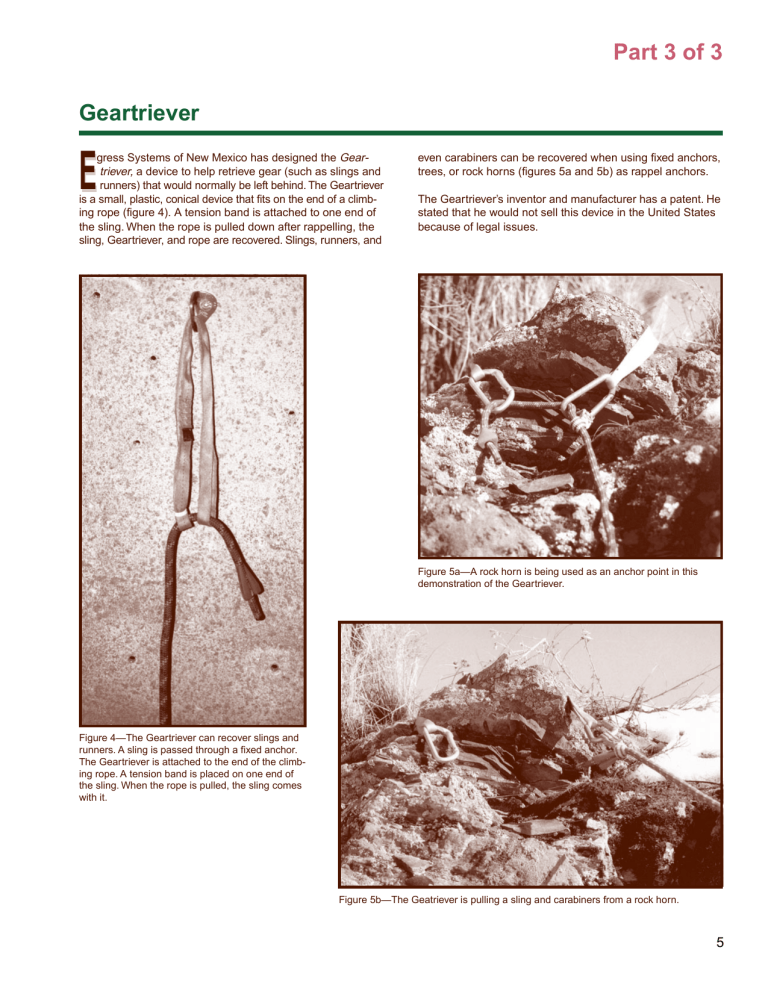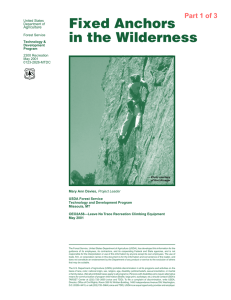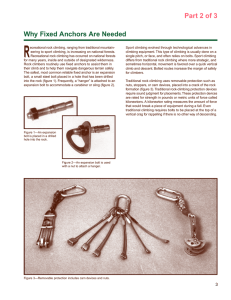E Part 3 of 3 Geartriever

Part 3 of 3
Geartriever
E E gress Systems of New Mexico has designed the Geartriever, a device to help retrieve gear (such as slings and runners) that would normally be left behind. The Geartriever is a small, plastic, conical device that fits on the end of a climbing rope (figure 4). A tension band is attached to one end of the sling. When the rope is pulled down after rappelling, the sling, Geartriever, and rope are recovered. Slings, runners, and even carabiners can be recovered when using fixed anchors, trees, or rock horns (figures 5a and 5b) as rappel anchors.
The Geartriever’s inventor and manufacturer has a patent. He stated that he would not sell this device in the United States because of legal issues.
Figure 5a—A rock horn is being used as an anchor point in this demonstration of the Geartriever.
Figure 4—The Geartriever can recover slings and runners. A sling is passed through a fixed anchor.
The Geartriever is attached to the end of the climbing rope. A tension band is placed on one end of the sling. When the rope is pulled, the sling comes with it.
Figure 5b—The Geatriever is pulling a sling and carabiners from a rock horn.
5
Part 3 of 3
Conclusions
T T he Center will continue to monitor the negotiated rulemaking process for a final policy on fixed anchors in the wilderness. When a final policy or specific climbing plan requires removing fixed anchors or climbing gear (such as slings and runners), the center can ask industry and designers to provide needed devices.
Sources of Information
Background documents, Federal Register Notice, and meeting note summaries: http://www.wilderness.net/issues/fs/fixed_anchor
Access Fund position statement: http://www.accessfund.org
Leave No Trace: Minimize Climbing Impacts: http://www.Int.org/RockClimbing/RockClimb.html
Outdoor Recreation Coalition of America (ORCA) position statement: http://www.orca.org/govt/positions/5.html
About the Author
Mary Ann Davies is a Project Leader working for the Facilities,
Recreation, Fire, and Watershed, Soil, and Air Programs. She received a bachelor’s degree in mechanical engineering with a minor in industrial and management engineering from Montana
State University in 1988. Her Forest Service career began in the Pacific Northwest Region where she worked with facilities, tramways, fire, and recreation. Mary Ann worked for the Rocky
Mountain Research Station’s Fire Sciences Laboratory in
Missoula before coming to MTDC in 1998.
Library Card
Davies, Mary Ann. 2001. Fixed anchors in wilderness. Tech.
Rep. 0123-2826-MTDC. Missoula, MT: U.S. Department of
Agriculture Forest Service, Missoula Technology and Development Center. 6 electronic p.
Describes an unsuccessful search for products that could eliminate the need for fixed climbing anchors in designated wilderness areas. Allowing fixed anchors, expansion bolts, and hangers in designated wilderness is controversial. Advocates of fixed anchors believe the anchors are essential for safety. Opponents of fixed anchors in wilderness base their argument in the statutory language of the Wilderness Act of
1964, which prohibits “installations” for other than administrative purposes. The Missoula Technology and Development Center located one product, the “Geartriever”, to retrieve gear (such as slings and runners) that would normally be left behind. The author thinks the likelihood of finding a technical solution that would make fixed anchors obsolete is slim.
Keywords: active recreation, climbing, climbing devices, equipment, recreation, regulations
For further technical information, contact Mary
Ann Davies at MTDC.
Phone: 406–329–3981
Fax: 406–329–3719
Lotus Notes: MaryAnn Davies/WO/USDAFS
E-mail: mdavies@fs.fed.us
Electronic copies of MTDC’s documents are available on the Forest Service’s FSWeb intranet at:
http://fsweb.mtdc.wo.fs.fed.us
6






